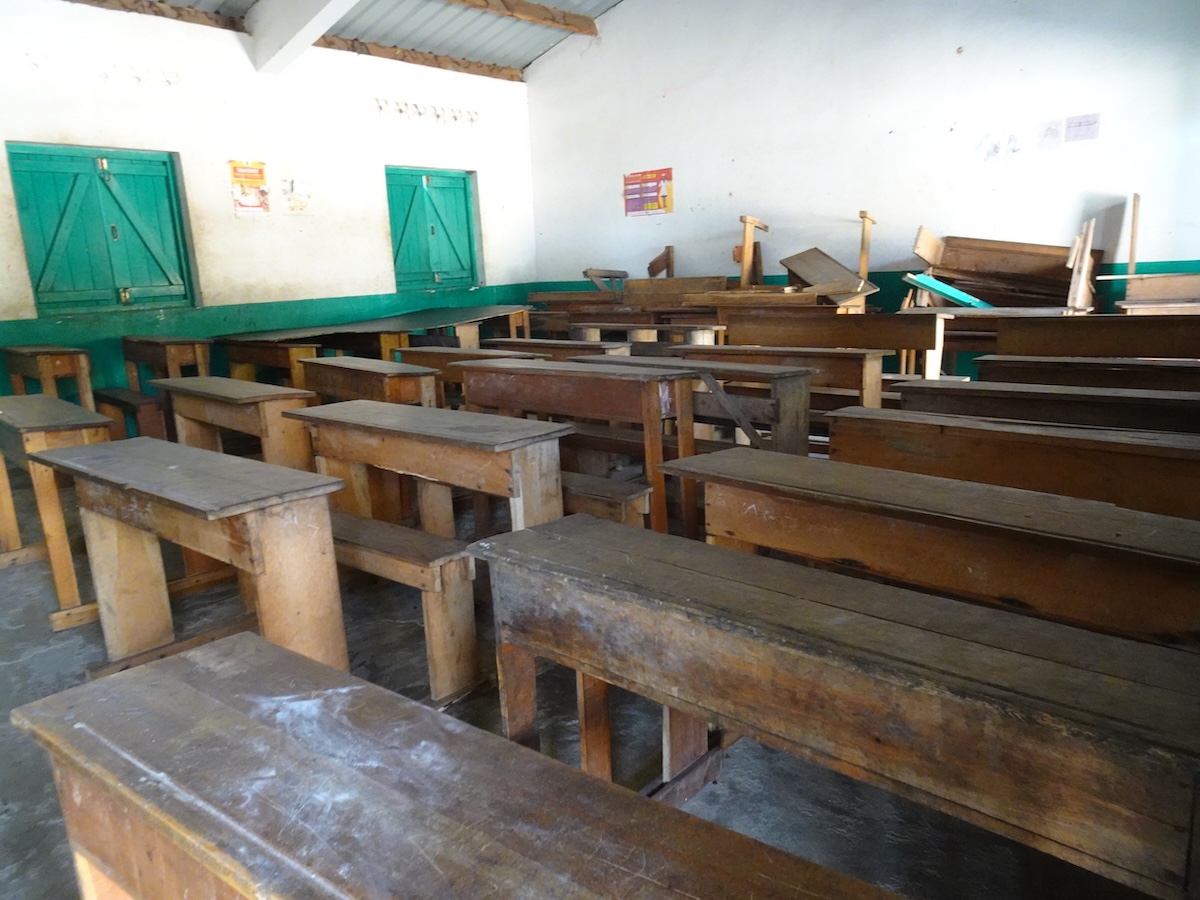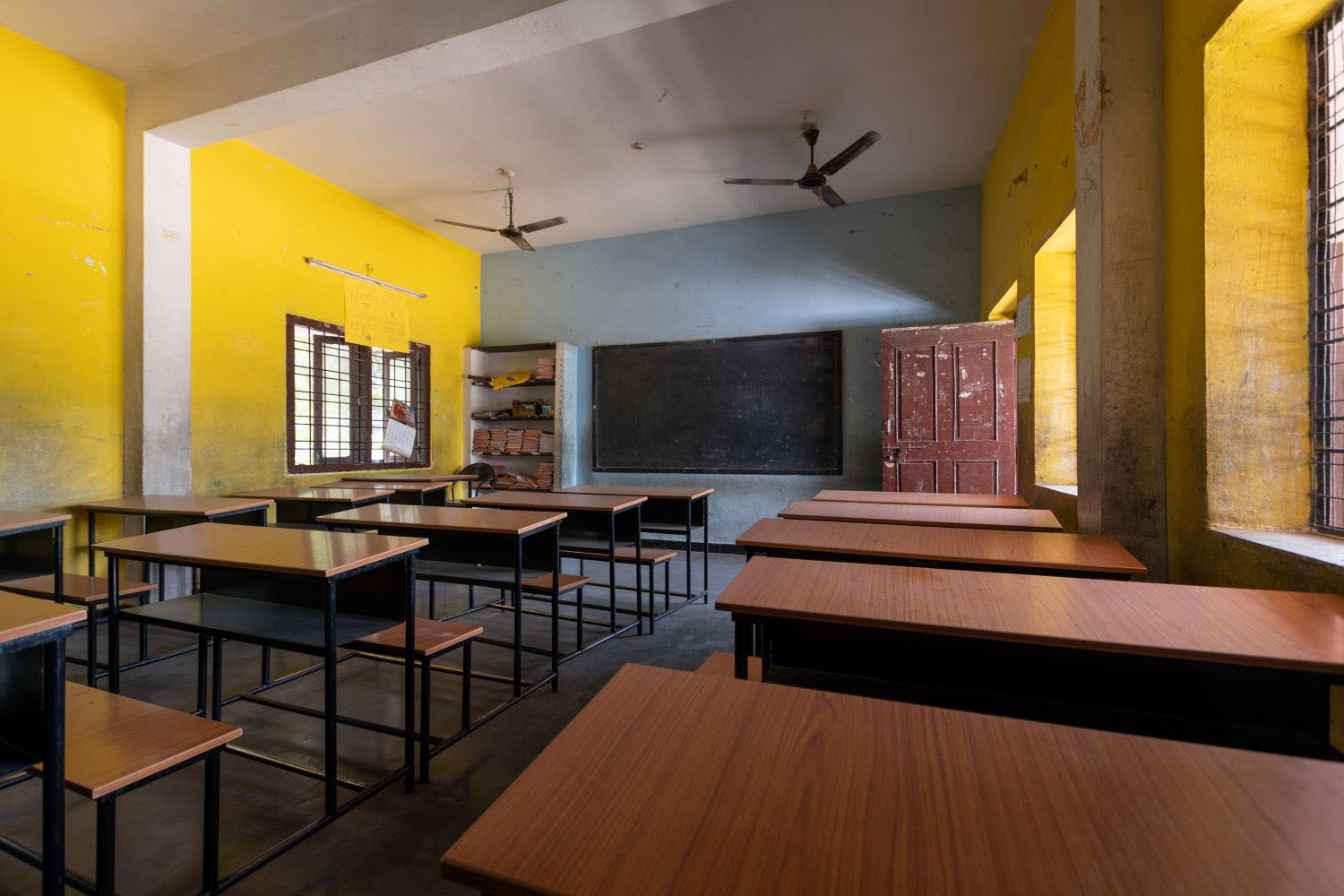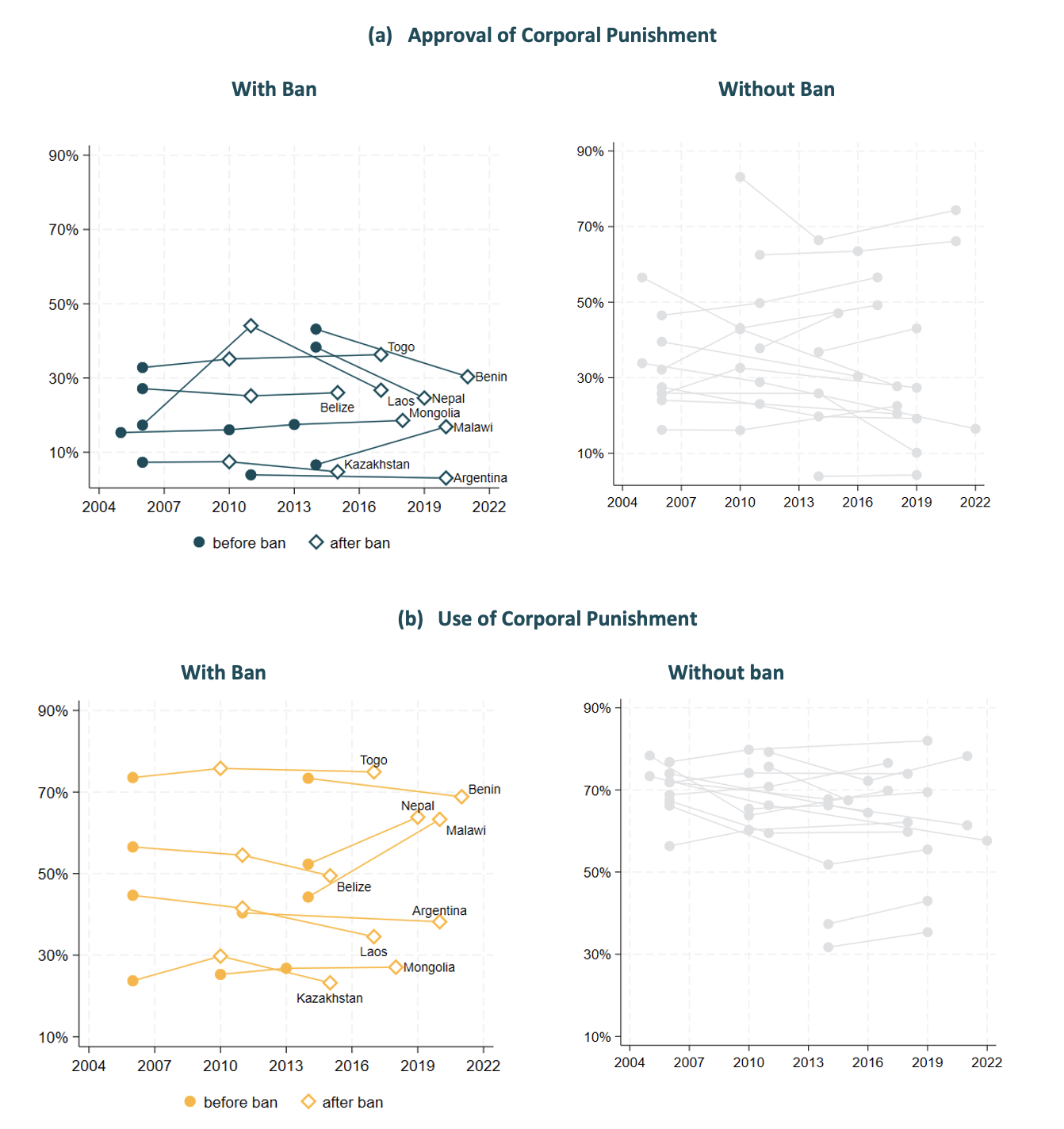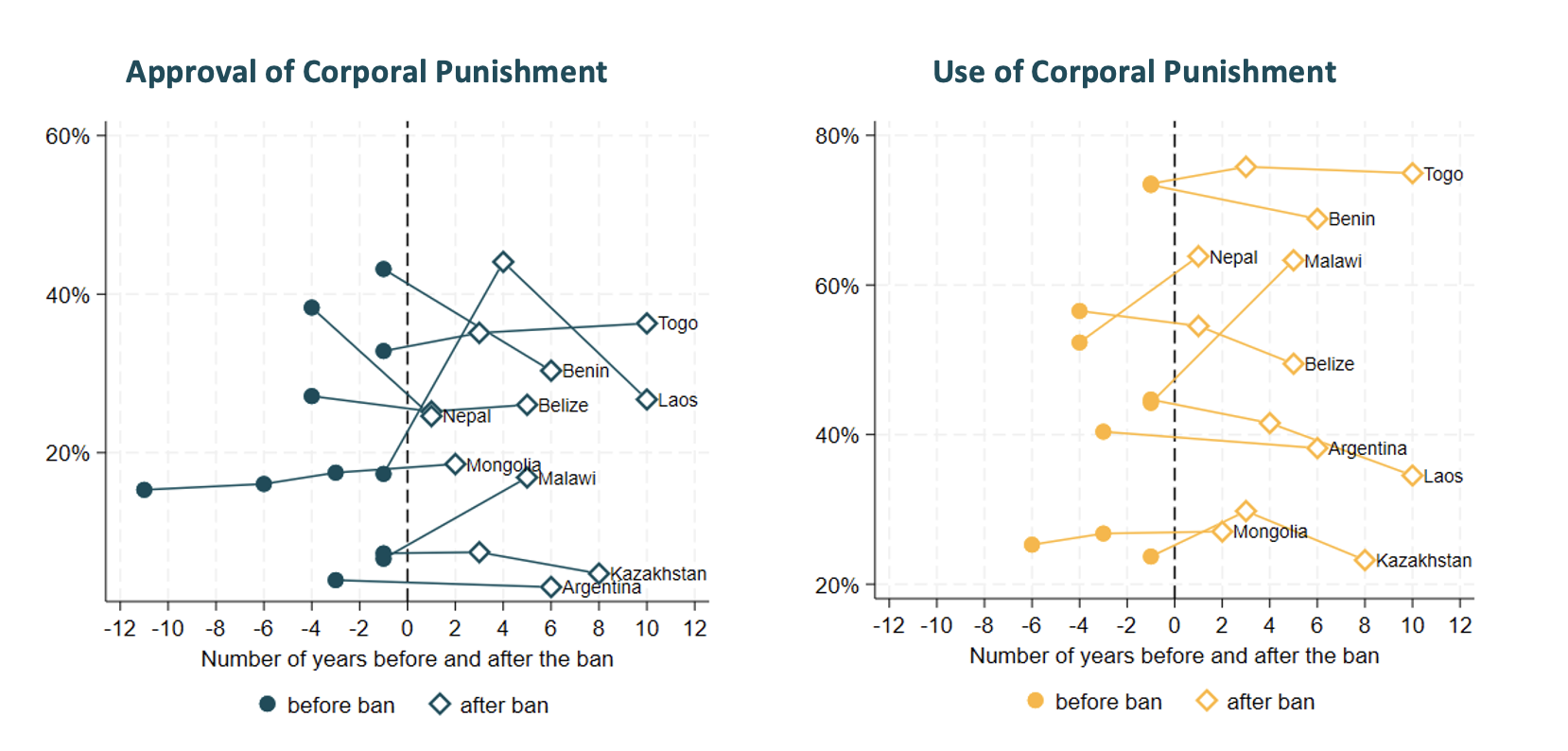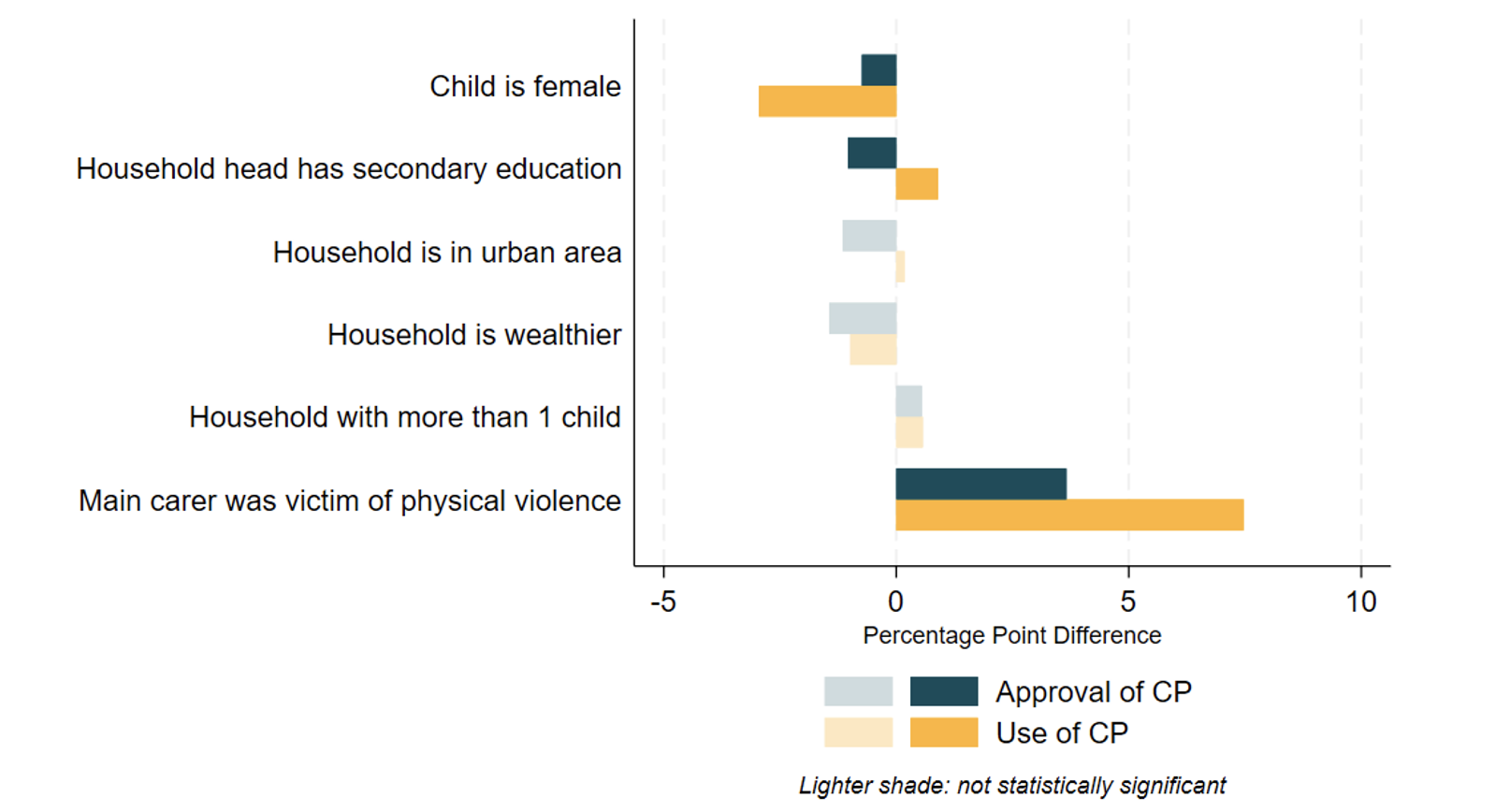Recommended
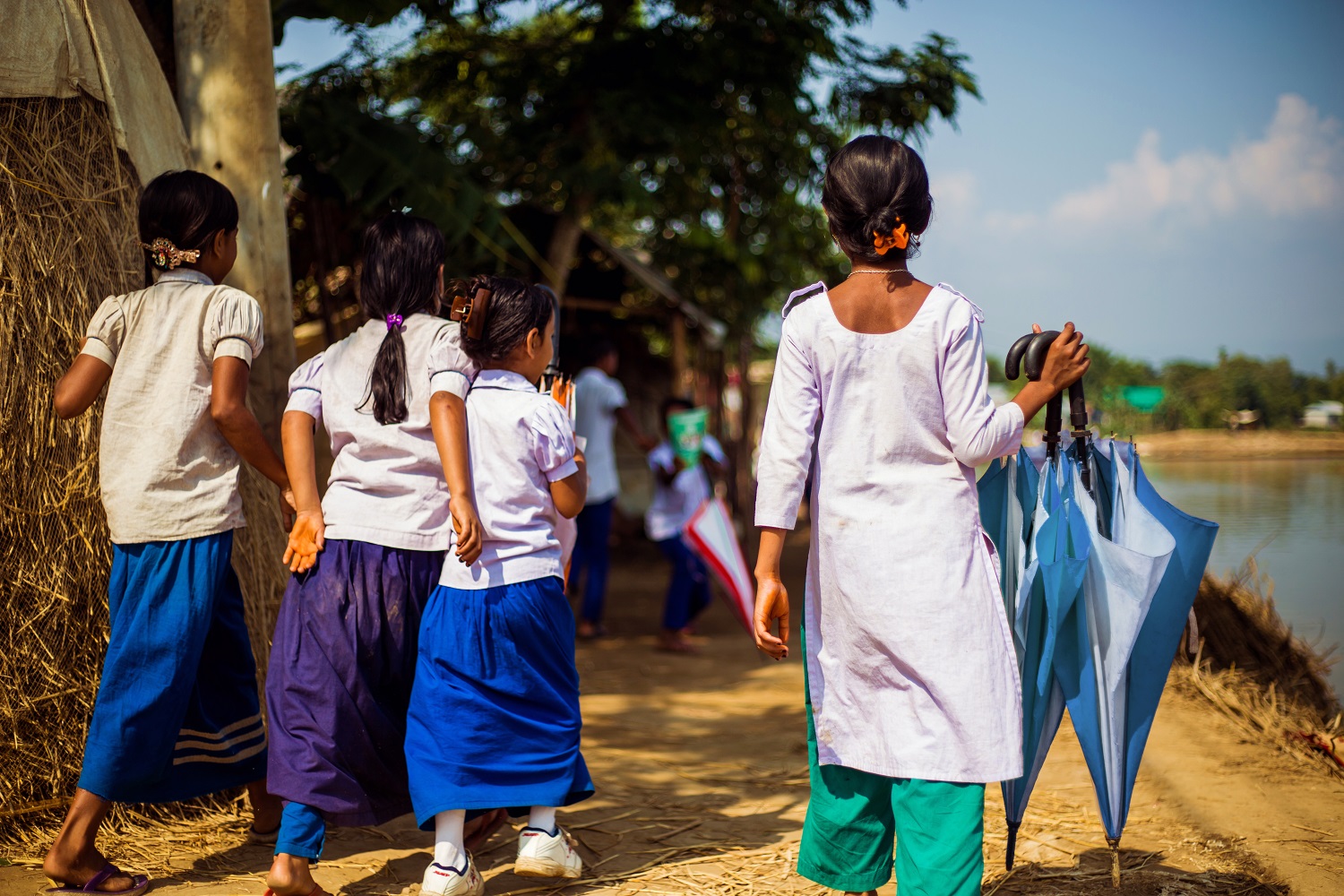
Blog Post

Blog Post
Children worldwide are exposed to high levels of corporal punishment, with rates higher than 90 percent in some settings. Corporal punishment, as defined by the UN Committee on the Rights of the Child, refers to “any punishment in which physical force is used and intended to cause some degree of pain or discomfort, however light.” This violence is a violation of children’s rights and studies have consistently shown the negative effects of corporal punishment on children’s learning potential, mental health and well-being, signalling the need to change societal attitudes, norms and behaviours around the use of corporal punishment.
Corporal punishment is legal in many countries. According to End Corporal Punishment, only 65 countries have a full ban—meaning prohibition of corporal punishment in schools, homes, and childcare facilities—with an additional 27 countries committed to such a prohibition. Corporal punishment in schools remains legal in 63 countries. Implementing and enforcing legislation that prohibits corporal punishment across all settings is an important step towards keeping children safe. But, how far does the passing of legislation go toward actually reducing rates of corporal punishment?
In this note, we explore whether bans have contributed to changing prevalence of, and support for, corporal punishment in low- and middle-income countries across time. Our analysis provides four main findings. First, although bans are necessary and important, they alone are not sufficient to end corporal punishment. The introduction of bans should be accompanied by other policies aiming to shift norms around the use of violence. Second, government and citizen alignment on views and norms about corporal punishment seems to be a precondition for implementing bans. Third, parents’ approval and use of corporal punishment are influenced by their own experiences of violence. It is therefore crucial to break the intergenerational transmission of violence. And fourth, we need better data to disentangle the causal impacts of bans and other more comprehensive policies within school settings.
Legislation does not always shift attitudes, norms, and behaviours
Legislation can work well to change attitudes, norms and behaviours. For example, using data from the Gallup World Poll, a global study found the legalisation of homosexuality positively influenced public attitudes towards homosexuality. And in the United States, comprehensive antibullying laws reduced suicidal behaviours among teenagers. However, well-intended regulation is not always effective. In India, for example, bans against child labour had some unintended consequences: child wages decreased in response to the bans and families utilized more child labour to compensate for the lower wages, leading to an increase in child employment and a reduction in school enrollment.
In the same way, the existing evidence on the effects of corporal punishment bans shows mixed results. A descriptive study from high-income countries found the approval for the use of corporal punishment and prevalence of corporal punishment significantly decreased after its prohibition in ten countries (Sweden, Finland, Austria, Germany, New Zealand, Romania, Poland, Denmark, Japan and the UK). Similarly, a longitudinal study found that parents' use and approval of corporal punishment decreased in Kenya after the ban. On the other hand, a study in nine countries with bans in all settings found that legislation did not affect the use of corporal punishment by parents.
We build on these findings and provide original analysis and insights by focusing on low- and middle-income countries and examining changes in the attitudes and use of corporal punishment in countries with and without bans over time.
Support for and prevalence of corporal punishment is lower in countries with bans
Analysis of Violence Against Children Surveys (VACS) data reveals children are less likely to have experienced corporal punishment by teachers[1] in the last year in countries with corporal punishment bans in schools, compared to those without bans (Figure 1). On average, around 6 percent of children reported experiencing corporal punishment by teachers in countries with bans, compared with 18 percent in countries without bans. A similar pattern emerges regarding parents' approval and use of corporal punishment at home.[2] Analysis of the latest data from Multiple Indicators Clusters Surveys (MICS) shows high levels of corporal punishment both in countries with and without corporal punishment bans (Figure 2). But, on average, in countries without bans a higher percentage of parents approve and use corporal punishment, with Sub-Saharan African countries exhibiting significantly higher agreement and prevalence rates compared to other regions. Moreover, we observe that lower support for corporal punishment does not always translate into lower use (Figure 2). For example, in Argentina, only three percent of parents self-report supporting the use of corporal punishment but more than one-third practice it. And, in Nepal, only three in 12 parents self-report support for corporal punishment, but eight in 12 practice it.
Figure 1. Fewer children are victims of corporal punishment in countries with bans
Figure 2. More parents use corporal punishment in countries without bans, but it is still widely used in countries with bans
But the introduction of bans alone is not enough to drive change
Of course, the observed differences described above cannot be attributed only to bans, as various confounding factors may influence teachers' and parents’ behaviours, including previous exposure to violence, perceived social norms and household demographic factors. And it could be that countries with bans were already in a downward trend before corporal punishment bans were introduced. To explore this further, we examine changes in attitudes to and use of corporal punishment across time using data from MICS. We used a sample of 24 countries, nine[3] with bans and 15 without bans by the time the survey was administered. Our analysis provides two key messages.
First, countries with bans already had lower levels of support for and use of corporal punishment at baseline (before the ban was introduced), relative to most countries without bans (Figure 3). On average, support and use of corporal punishment was already 22 and 20 percentage points lower in countries with bans relative to countries without bans in the early 2000s. This would suggest that countries with lower levels of corporal punishment are more likely to introduce bans—partly because governments’ and citizens’ agreement on the harmful nature of some practices can facilitate the introduction of bans. We observe this pattern in a study on the first country banning corporal punishment (i.e. Sweden), which found that changes in public opinion may have generated the 1979 legal reform on corporal punishment in Sweden and not vice versa.
Figure 3. On average, countries with bans have less corporal punishment before the introduction of the ban
Source: Authors’ analysis from the Multiple Indicators Cluster Survey (MICS). Note: Countries without bans (by the time MICS data was collected) include 10 countries in Africa, 1 in Asia, and 4 in Latin America and the Caribbean. To review the proportion of parents who report approval and use corporal punishment see the online appendix here.
Second, bans are not sufficient to drive change alone. Looking at data one to six years before bans are introduced and one to 10 years after (Figure 4), we observe significantly different trends by country. Parents’ support for or use of corporal punishment significantly decreased after introducing bans in four of nine countries, while it increased in four countries and remained the same in one country. We explored whether the degree of comprehensiveness of the bans might explain these differences in trends by classifying bans into three categories: high, medium, and low levels of comprehensiveness (Table 1). “High” refers to legislation that explicitly bans the use of corporal punishment in all settings. “Medium” refers to legislation that explicitly bans the use of corporal punishment only in schools[4], and “low” levels of comprehensiveness refer to bans that only implicitly prohibit corporal punishment or are not based on legislation. Regardless of the type of ban, we observe statistically significant increases in the use of corporal punishment over time both in countries with more comprehensive (Nepal and Mongolia) and less comprehensive bans (Malawi), suggesting that the heterogeneous trends are not necessarily explained by the type of ban.
In countries without bans, the trends also vary significantly between countries (Figure 3). In nine out of 15 countries without bans, parents’ use of corporal punishment significantly decreased over time, while it increased in the remaining countries. The data also shows some contradictory patterns. For example, in Laos, the self-reported support for corporal punishment increased (with a surprising jump four years after the ban was introduced) but the use of corporal punishment decreased. Similarly, in Nepal, the self-reported support for corporal punishment decreased after the ban but the use of corporal punishment increased. These cases demonstrate the importance of collecting data more regularly for a better analysis of time trends.
Figure 4. Corporal punishment did not decrease in most countries after the introduction of the ban
Source: Authors’ analysis from the Multiple Indicators Cluster Survey (MICS). Note: The countries in our sample had bans at different points in time (for example, in Togo a full ban was achieved in 2007 and in Argentina in 2014). To account for this, in this graph, the year of the ban is centred to zero. Zero indicates the year when the ban was enacted. The periods below zero indicate the number of years before the ban, and the periods above zero indicate the number of years after the ban. In Mongolia, 2005 MICS did not have enough data to construct the indicator of corporal punishment use.
Table 1. Degree of comprehensiveness of laws
|
Degree |
Definition |
Countries |
|---|---|---|
|
High |
Explicitly prohibit the use of corporal punishment in all settings. Example: Argentina's Civil and Commercial Code 2014 says "All forms of corporal punishment, ill-treatment and any act that physically or mentally injures or impairs children and adolescents are prohibited (...)" |
Argentina, Benin, Mongolia, Nepal and Togo |
|
Medium |
Explicitly prohibit the use of corporal punishment in schools. Example: Belize's Education and Training Act 2010 says “School authorities shall ensure that pupils are free at school from physical, sexual or other forms of harassment, from intimidation and corporal punishment (…) nothing in the statement of general principles and measures or measures for regulating the conduct of students shall authorise anything to be done in relation to a student which constitutes harassment, intimidation, the administering of corporal punishment or any other actions harmful to a student.” |
Belize, Kazakhstan and Laos |
|
Low |
Implicitly ban corporal punishment or that are not based on legislation (i.e., forbid corporal punishment through an education plan). Example: Malawi National Education Standards 2015 for primary and secondary education prohibit the use of corporal punishment. End Corporal Punishment explains it is not clear if the National Education Standards apply to private schools. |
Malawi |
Source: Authors created the typology using as a reference the legislation systematized by End Corporal Punishment.
The mixed trends in countries with and without bans shed light on the importance of rigorously disentangling which institutional, community and individual-level factors drive the decision to use corporal punishment. Corporal punishment bans are an important step to signal the country's commitment to ending this practice, but they alone are not sufficient. It could be that individuals are not aware that their countries have banned the use of corporal punishment, or even if they are aware, the lack of enforcement of the bans undermines their potential effectiveness. And some studies show that harmful norms and behaviours may persist despite laws, particularly when individuals strongly disagree with the law and perceive that most members of their community also disagree with it. Therefore, legal bans might be effective only when coupled with other interventions aiming to shift norms progressively. Some successful interventions include executing information campaigns on the consequences of harmful practices, involving community leaders to shift norms at a higher level, and providing strategies to replace existing harmful practices (such as positive discipline strategies).
Parents who have experienced violence are more likely to use and approve of corporal punishment
What are some of the other determinants of parents’ attitudes and use of corporal punishment? An important driver relates to the parents’ own experiences of physical violence. Our analysis indicates that those parents who report being victims of physical violence are more likely to use corporal punishment (Figure 5). This finding supports the evidence on the intergenerational transmission of violence and points to the importance of breaking the cycle of violence. And, similar to some empirical literature, Figure 5 shows that parents with female children are less likely to support and use corporal punishment. We also see that households where the head has secondary education are less likely to approve of corporal punishment, but are more likely to actually practice corporal punishment. Such inconsistency between approval and practice confirms our previous observation that opinion on corporal punishment does not always predict its use. There are, of course, many other factors for which we did not have data that might explain corporal punishment practices. Still, overall our analysis points to some that should be considered when designing interventions to end corporal punishment.
Figure 5. Parents who have experienced violence are more likely to support and use corporal punishment
Source: Authors’ analysis from the Multiple Indicators Cluster Survey (MICS). Note: Figure 3 displays the coefficient estimates from a regression that controls for several household and child characteristics. For details on all covariates, review the online appendix here. We only used the latest round of MICS data in this Figure as this round includes data on parents’ experience of violence and the estimates only include 11 countries (3 with bans and 8 without bans) that have data on parents’ previous experience of physical violence.
Corporal punishment bans: Necessary but not sufficient
Our analysis provides four main takeaways.
First, corporal punishment bans are not enough to drive change alone. Comparing countries with and without bans at one point in time suggests that countries with bans have less support for and use of corporal punishment. However, when accounting for time trends, we notice that bans are not always associated with a statistically significant decrease in the approval and use of corporal punishment. This does not mean that bans should not be introduced. Bans in all settings are crucial, but they are not sufficient. Additional actions and policies aiming to enforce the bans, increase awareness of bans and shift norms are needed to increase their effectiveness. Empirical evidence on anti-bullying laws shows that stronger laws accompanied by training and transparency provisions for schools, students, and families were more effective in reducing the probability of being bullied. This highlights the importance of using comprehensive strategies to end corporal punishment in schools.
Second, governments’ and citizens’ alignment over the harmful nature of corporal punishment might be an important precondition for implementing bans and ensuring their effectiveness. Our analysis shows that in countries that adopted bans first, their initial levels of support for and use of corporal punishment were lower relative to countries without bans, perhaps facilitating the enactment of the bans. And, in countries with higher approval of corporal punishment, it’s logical that the effectiveness of bans might be undermined by disagreement with the bans. Therefore, implementing interventions that progressively contribute to shifting norms emerges as a fundamental—though challenging—step to drive change. Civil society organizations can be an important partner to achieve this by supporting the delivery of interventions and encouraging dialogue between governments and citizens.
Third, we need to break the intergenerational cycle of violence. Parents who have experienced violence themselves are more likely to use corporal punishment. This is also the case for teachers. Preventing corporal punishment today will reduce victims’ likelihood of becoming perpetrators in the future.
Fourth, our analysis is descriptive and based only on 24 countries. We need better data to identify the causal impacts of corporal punishment bans and to understand if their effectiveness changes when coupled with other interventions. This is particularly important in the context of schools, where we currently lack data to monitor changes in corporal punishment practices across time. Moving forward, researchers might need to prioritise focusing on single-country over multi-country studies to carefully account for each country's context, culture, and social norms.
[1] The prevalence of corporal punishment by teachers is measured as the percentage of students experiencing any physical violence perpetrated by teachers in the past 12 months.
[2] The approval of corporal punishment is measured as the percentage of respondents agreeing to “Do you believe that in order to bring up, raise, or educate a child properly, the child needs to be physically punished?” The use of corporal punishment is measured as the percentage of carers using any form of physical violence on the child in the past one month, including spanking with bare hand; hitting with hard objects; slapping on the face, head, ears; slapping on the extremities; beating up as hard as one could and shaking the child.
[3] We only keep countries with bans that have data before and after the ban was implemented.
[4] In these countries, a school ban on corporal punishment could serve as a social norm that communicates to parents that such behaviour is unacceptable.
With many thanks to Lee Crawfurd, Ali Hendy, Radhika Nagesh and Justin Sandefur for their comments and contributions.
Rights & Permissions
You may use and disseminate CGD’s publications under these conditions.


